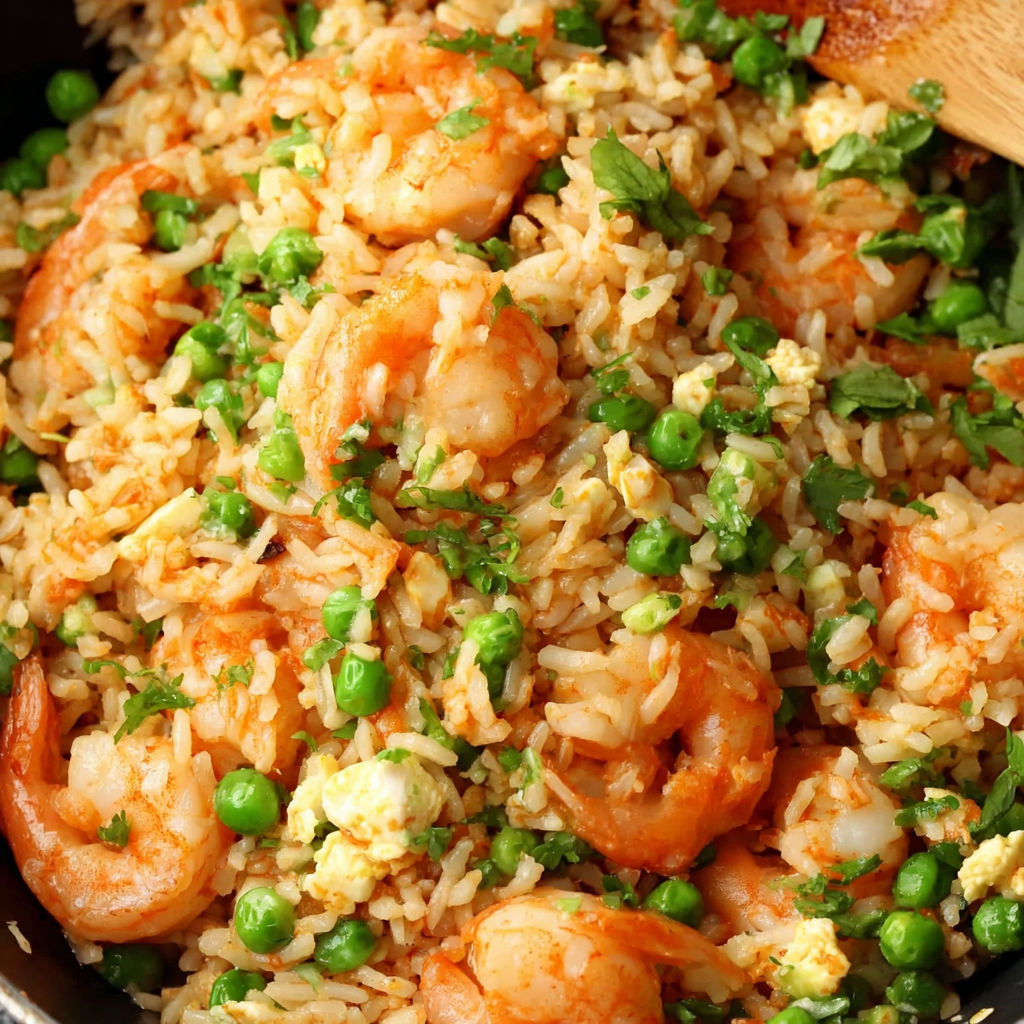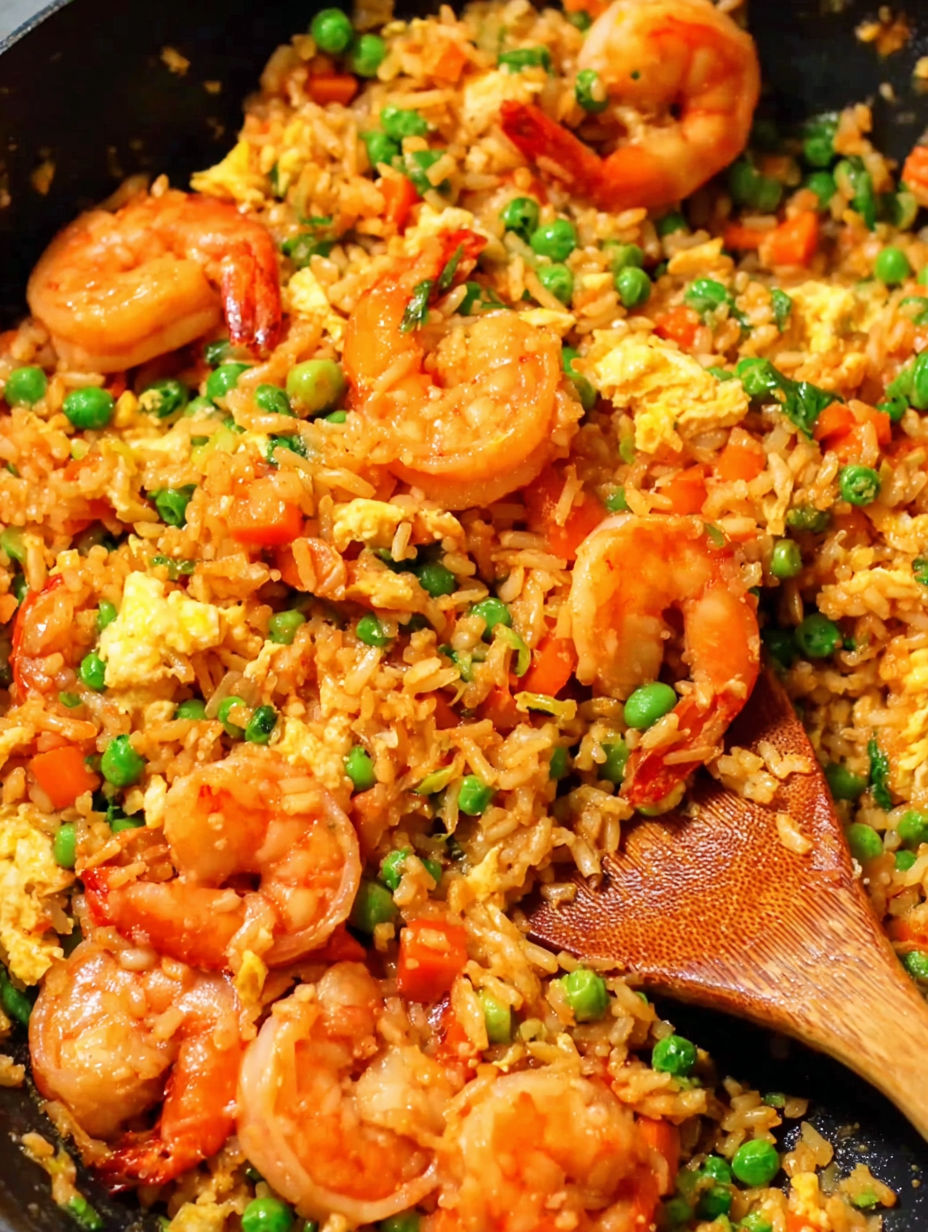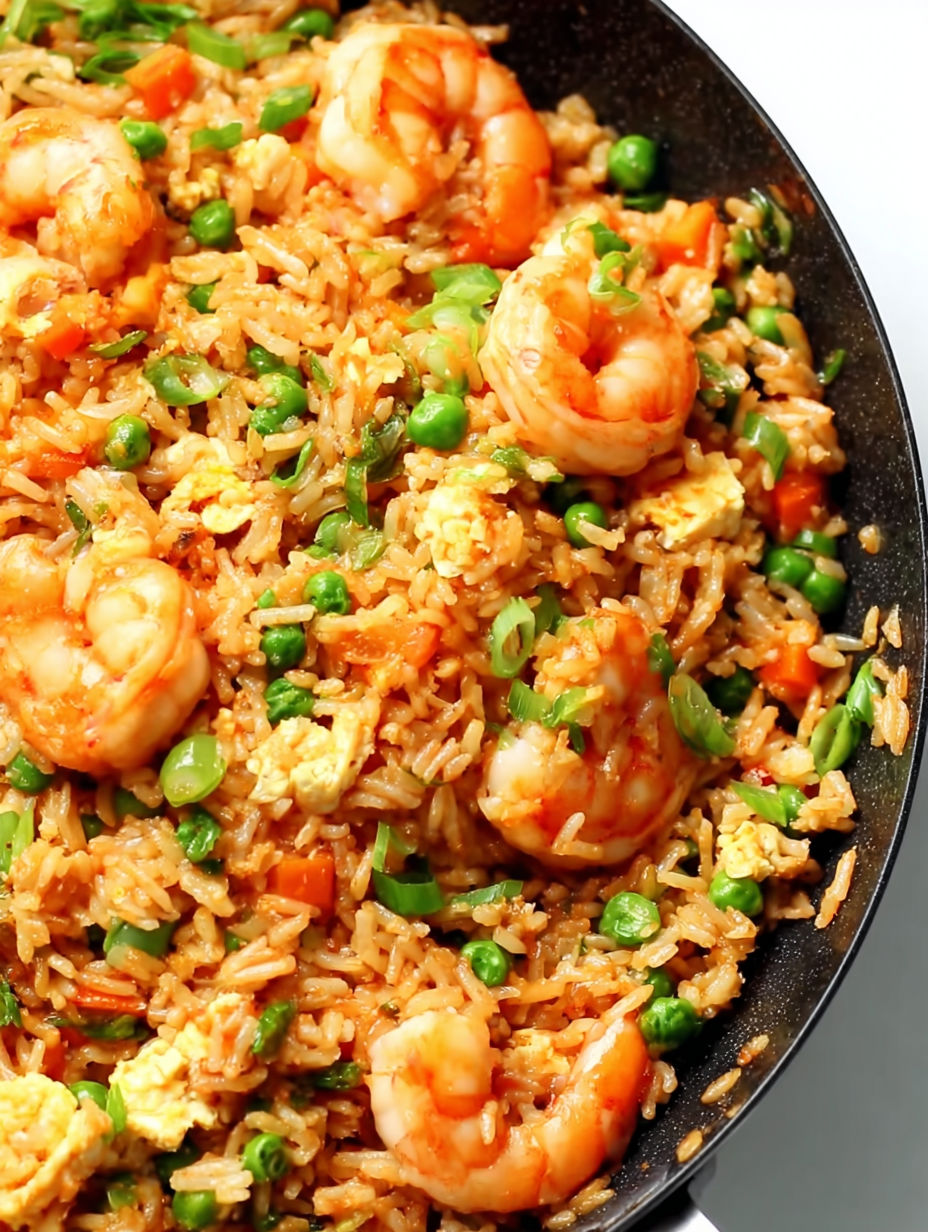 Bookmark
Bookmark
You will never need to order takeout again with this amazing and easy shrimp fried rice recipe. It is packed with perfectly cooked rice, fresh shrimp, onions, carrots, peas, egg, scallions, and hints of garlic and ginger all tossed in a flavorful homemade sauce made from soy sauce, oyster sauce, rice vinegar, and sesame oil. Fried rice is surprisingly easy to make at home, and adding shrimp only takes an extra few minutes which makes it perfect for a quick yet satisfying meal.
I first made this recipe when I was craving Chinese takeout but wanted to control the ingredients. Since then it has become a quick favorite that my whole family asks for regularly.
Ingredients
- Shrimp: One pound of cleaned and deveined shrimp for the best texture and flavor. If using frozen be sure to thaw and drain them well to avoid sogginess
- Soy sauce: Low sodium soy sauce helps keep the dish well balanced without overwhelming saltiness. Use gluten free soy or tamari if you need it gluten free
- Chicken broth: Adds a subtle depth to the shrimp during cooking boosting flavor without heaviness
- Peanut oil: For cooking provides a neutral but slightly nutty oil that withstands the high heat needed for stirfrying
- Yellow onion: Diced to bring sweetness and crunch to the dish
- Frozen peas: Thawed offer a pop of color and fresh taste without any extra prep
- Carrot: Medium carrot diced for a bit of natural sweetness and texture
- Garlic and ginger: Fresh garlic and ginger pressed and grated to add that essential aromatic lift that makes fried rice sing
- Eggs: Two eggs whisked with a splash of soy sauce add richness and a savory binding element
- Sauce: Rice vinegar sesame oil soy sauce and oyster sauce mixed together create a sauce that delivers sweet tangy and umami flavors perfectly balanced
- Rice: Four cups cooked long grain white rice ideally leftover and chilled so it fries up dry and fluffy
- Scallions: Chopped scallions for freshness and color just before serving
Instructions
- Sear the Shrimp:
- Preheat a large wok or deep nonstick pan over mediumhigh heat with peanut oil. Add the shrimp mixed with low sodium soy sauce pressed garlic and chicken broth. Cook for about 2 minutes on each side until they turn opaque and slightly pink. Remove shrimp from the pan and set aside to avoid overcooking.
- Cook the Vegetables:
- Add a bit more peanut oil to the pan and lower heat to medium. Add diced onion and carrot stir frequently and saute until starting to soften about 3 to 4 minutes. Add thawed peas and a splash of soy sauce. Continue to cook until the vegetables are tender but still vibrant.
- Add Aromatics:
- Push the cooked vegetables to the sides of the pan to create a small well in the center. Place the pressed garlic and grated ginger into the well and saute just until fragrant about 30 seconds. Mix the aromatics evenly with the vegetables afterward.
- Cook the Eggs:
- Make room again in the center of the pan and pour in the whisked eggs mixed with soy sauce. Allow the eggs to sit undisturbed for about a minute until partially set then gently scramble and fold them into the vegetables. Cover the pan for a brief moment if you want fluffier eggs.
- Incorporate Rice:
- Fluff the cold cooked rice with a fork to break apart any clumps. Add it to the pan and stir well to combine with the eggs and vegetables ensuring the rice is heated through evenly.
- Return Shrimp and Add Scallions:
- Add the cooked shrimp and chopped scallions back to the pan. Pour your premixed sauce evenly over everything and gently fold it through the rice to coat all ingredients well.
- Final Sauté:
- Allow the entire mixture to saute together for a couple more minutes to blend flavors and slightly caramelize the rice underneath without burning. Then it is ready to serve.

One of my favorite ingredients to watch transform in this dish is the eggs. When cooked just right they add a silky richness that holds everything together without weighing it down. This recipe reminds me of the first time I made shrimp fried rice for a small dinner party. Everyone was shocked it was homemade and eager for seconds proving you do not need a takeout menu to enjoy great Chinese flavors at home.
Ingredient Substitutions
If you do not have shrimp cooked diced chicken or tofu both work well in this recipe. For a veggie packed version feel free to add chopped broccoli baby corn or diced green beans. Swap peanut oil with vegetable or canola oil if allergies are a concern. If you cannot find oyster sauce use more soy sauce combined with a touch of hoisin sauce for sweetness and depth.
Storage Tips
Shrimp fried rice stores very well in an airtight container in the refrigerator for up to three days. When reheating add a small splash of chicken broth or water to keep the rice moist and warm it over medium heat stirring frequently. Avoid the microwave if possible as shrimp tends to become rubbery.
Serving Suggestions
Serve your shrimp fried rice alongside steamed bok choy or a simple cucumber salad for a fresh and crunchy contrast. A drizzle of chili oil or a side of pickled vegetables adds a welcome spicy kick. This dish stands well on its own too perfect for busy weeknights or meal prep lunches.

This shrimp fried rice is quick adaptable and tastes better than takeout. It is perfect for busy weeknights or meal prep.
FAQs About This Recipe
- → What type of rice works best for this dish?
Long grain white rice, preferably chilled leftover rice, provides the best texture and separation when cooked with shrimp and vegetables.
- → Can I use frozen shrimp instead of fresh?
Yes, just ensure the shrimp are fully thawed and drained to avoid excess moisture affecting the cooking process.
- → How should this dish be reheated for best flavor?
Reheat gently in a pan or wok over medium-low heat with a splash of broth or soy-based liquid to preserve texture and flavor, avoiding microwaving.
- → What vegetables complement the shrimp and rice well?
Classic choices like diced onions, carrots, peas, and scallions work beautifully, with options to add broccoli, asparagus, or baby corn for variation.
- → How is the sauce prepared to enhance the dish?
The sauce combines soy sauce, oyster sauce, rice vinegar, and sesame oil, creating a harmonious balance of salty, tangy, and nutty flavors that coat the ingredients evenly.
